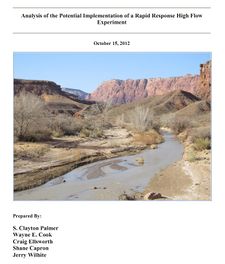GCDAMP- Resource Models
| Rapid Response Manuscript | |
 |
- Please find the following document enclosed “An Analysis of the Rapid Response High Flow Experiment – Implementation.”
- This analysis is provided to support Reclamation’s intention to implement a Rapid Response experiment as described in Reclamation’s “Final Environmental Assessment for the Development and Implementation of a Protocol for High-Flow Experimental Releases from Glen Canyon Dam, Arizona, 2001-2020” (EA). The experiment would time maximum powerplant releases at Glen Canyon Dam (GCD) with Paria River floods, primarily to help restore beach and backwater areas in Marble Canyon. However, concerns were raised in the EA, and additional follow up was needed before a test could be implemented. We hope that this document helps to answer some of the questions that Reclamation may have, specifically relating to operations.
The research described in this document:
- identifies how operationally Paria River flood events can be linked to maximum powerplant releases from GCD to induce sediment-enriched flows in Marble Canyon,
- describes how Western can manipulate power schedules to facilitate a Rapid Response HFE and includes several examples,
- shows that Paria River floods can be adequately predicted and that a flood can be timed to be coincident with a flood reaching the mainstem,
- shows the types of pre-planning that will need to be in place, and
- shows what additional consideration will be needed, working with the NPS, related to safety issues for recreational users downstream.
This research allows the authors to conclude that these flood events can be successfully timed with maximum powerplant flows at GCD to have similar stage as bypass assisted high flow events. The document also identifies how operations at GCD can be adjusted to respond to the short-time notice (hours) of impending flood flows at the mouth of the Paria River as well as the safety implications of rapid high-flow changes below GCD and in the upper reaches of the Grand Canyon. Reclamation’s Technical Report No. SRH-2012-08, “Determining Large Flood Events on the Paria River for a Rapid Response Alternative High Flow Experiment,” also addresses similar technical information.
The analysis provided in this document, along with Reclamation’s technical report mentioned above, Western’s September 2010 proposal, and the EA should provide sufficient information to begin further National Environmental Policy Act compliance for a Rapid Response HFE protocol and the development of a science plan. We understand that safety issues need further consideration and we would look forward to discussing these with the National Park Service and others.
Western is available to work with the Department of the Interior and the Colorado River Basin States to test and implement these operational changes and to move forward with Rapid Response HFE protocol that can both sustain the value of power generation at GCD and conserve sediment resources in the upper reaches of Grand Canyon to the maximum amount possible.
Contributor: Craig Ellsworth, Western Area Power Administration Category: Sediment